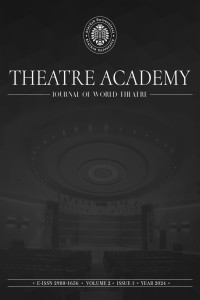Abstract
This article takes into account Fernando de Rojas’s La Celestina and compare some of the core features of the homonymous protagonist with some Shakespearean characters, examples mainly taken from The Tempest and A Midsummer’s Night Dream. Although a century divides the two authors and there is no recorded evidence of a connection between them, a comparative analysis is still feasible. While it may be impossible to establish a concrete link between Shakespeare and de Rojas, it may be beneficial to consider how certain core features of Celestina are portrayed within some Shakespearean protagonists. This has much more to do with the evolution of literature itself and how its boundaries are not only fluid but also how they intertwine in many occasions amongst themselves.
References
- Bados-Ciria, C. (1996). Celestina y el lenguaje del cuerpo. Celestinesca, 20(1-2), 75-88.
- Barbera, R. E. (1965). A Harlot, a Heroine. Hispania, 48(4), 790-799.
- Borges, J. L. (1964). Labyrinths: Selected Stories and Other Writings. D. A. Yates & J. E. Irby (Eds.). New York: New Directions Publishing.
- Chambers, E. K. (1989). William Shakespeare: A Study of Facts and Problems. London: Oxford University Press.
- Cooper, H. (2004). The English Romance in Time – Transforming Motifs from Geoffrey of Monmouth to the Death of Shakespeare. London: Oxford University Press.
- De Rojas, F. (1989). La Celestina. Madrid: Catedra.
- Dutton, R. (1989). William Shakespeare - A literary life. London: Palgrave Macmillan.
- Gilman, S. (1972). The Spain of Fernando de Rojas – The intellectual and social landscape of La Celestina. New Jersey: Princeton University Press.
- Goytisolo, J. (2009). Introduction. In F. de Rojas, Celestina. New York: Penguin Classics.
- Gray, D. (2020). “Command these elements to silence”: Ecocriticism and The Tempest. Literature Compass, 17(3-4), e12566.
- Pérez Fernández, J. M. (2013). James Mabbe, The Spanish bawd. London: Modern Humanities Research Association.
- Round, N. G. (1997). Rojas’ old bawd and Shakespeare’s old lady: the Anglican Reformation. Celestinesca, 21, 93-109.
- Ruiz Moneva, A. (2010). Main Aspects of the Reception and Conveyance of Irony in the Earliest English Versions of "Celestina". Celestinesca, 34, 99-144.
- Shakespeare, W. (2002). The Tempest. C. Dymkowski (Ed.). Cambridge: Cambridge University Press.
- Shakespeare, W. (1996). A Midsummer Night’s Dream. T. R. Griffiths (Ed.). Cambridge: Cambridge University Press.
- Shakespeare, W. (2005). Othello. J. Hankey (Ed.). Cambridge: Cambridge University Press.
- Shakespeare, W. (2002). Romeo and Juliet. J. N. Loehlin (Ed.). Cambridge: Cambridge University Press.
- Shakespeare, W. (2004). Macbeth. J. Wilders (Ed.). Cambridge: Cambridge University Press.
- Snow J. T. (2000). The sexual landscape of Celestina: Some observations. Calíope: Journal of the Society for Renaissance and Baroque Spanish Poetry, 6(1-2), 149-166.
- Valbuena, O. L. (1994). Sorceresses, Love Magic, and the Inquisition of Linguistic Sorcery in Celestin. PMLA, 109(2), 207-224.
- Yamamoto-Wilson J. R. (2012). Mabbe’s Maybes: A Stuart Hispanist in Context. Translation and Literature, 21(3), 319-342.
Abstract
References
- Bados-Ciria, C. (1996). Celestina y el lenguaje del cuerpo. Celestinesca, 20(1-2), 75-88.
- Barbera, R. E. (1965). A Harlot, a Heroine. Hispania, 48(4), 790-799.
- Borges, J. L. (1964). Labyrinths: Selected Stories and Other Writings. D. A. Yates & J. E. Irby (Eds.). New York: New Directions Publishing.
- Chambers, E. K. (1989). William Shakespeare: A Study of Facts and Problems. London: Oxford University Press.
- Cooper, H. (2004). The English Romance in Time – Transforming Motifs from Geoffrey of Monmouth to the Death of Shakespeare. London: Oxford University Press.
- De Rojas, F. (1989). La Celestina. Madrid: Catedra.
- Dutton, R. (1989). William Shakespeare - A literary life. London: Palgrave Macmillan.
- Gilman, S. (1972). The Spain of Fernando de Rojas – The intellectual and social landscape of La Celestina. New Jersey: Princeton University Press.
- Goytisolo, J. (2009). Introduction. In F. de Rojas, Celestina. New York: Penguin Classics.
- Gray, D. (2020). “Command these elements to silence”: Ecocriticism and The Tempest. Literature Compass, 17(3-4), e12566.
- Pérez Fernández, J. M. (2013). James Mabbe, The Spanish bawd. London: Modern Humanities Research Association.
- Round, N. G. (1997). Rojas’ old bawd and Shakespeare’s old lady: the Anglican Reformation. Celestinesca, 21, 93-109.
- Ruiz Moneva, A. (2010). Main Aspects of the Reception and Conveyance of Irony in the Earliest English Versions of "Celestina". Celestinesca, 34, 99-144.
- Shakespeare, W. (2002). The Tempest. C. Dymkowski (Ed.). Cambridge: Cambridge University Press.
- Shakespeare, W. (1996). A Midsummer Night’s Dream. T. R. Griffiths (Ed.). Cambridge: Cambridge University Press.
- Shakespeare, W. (2005). Othello. J. Hankey (Ed.). Cambridge: Cambridge University Press.
- Shakespeare, W. (2002). Romeo and Juliet. J. N. Loehlin (Ed.). Cambridge: Cambridge University Press.
- Shakespeare, W. (2004). Macbeth. J. Wilders (Ed.). Cambridge: Cambridge University Press.
- Snow J. T. (2000). The sexual landscape of Celestina: Some observations. Calíope: Journal of the Society for Renaissance and Baroque Spanish Poetry, 6(1-2), 149-166.
- Valbuena, O. L. (1994). Sorceresses, Love Magic, and the Inquisition of Linguistic Sorcery in Celestin. PMLA, 109(2), 207-224.
- Yamamoto-Wilson J. R. (2012). Mabbe’s Maybes: A Stuart Hispanist in Context. Translation and Literature, 21(3), 319-342.
Details
| Primary Language | English |
|---|---|
| Subjects | Literary Studies (Other) |
| Journal Section | Araştırma Makaleleri/Research Articles |
| Authors | |
| Early Pub Date | March 13, 2024 |
| Publication Date | March 16, 2024 |
| Submission Date | July 29, 2023 |
| Published in Issue | Year 2024 Volume: 2 Issue: 1 |
Content of this journal is licensed under a Creative Commons Attribution NonCommercial 4.0 International License


